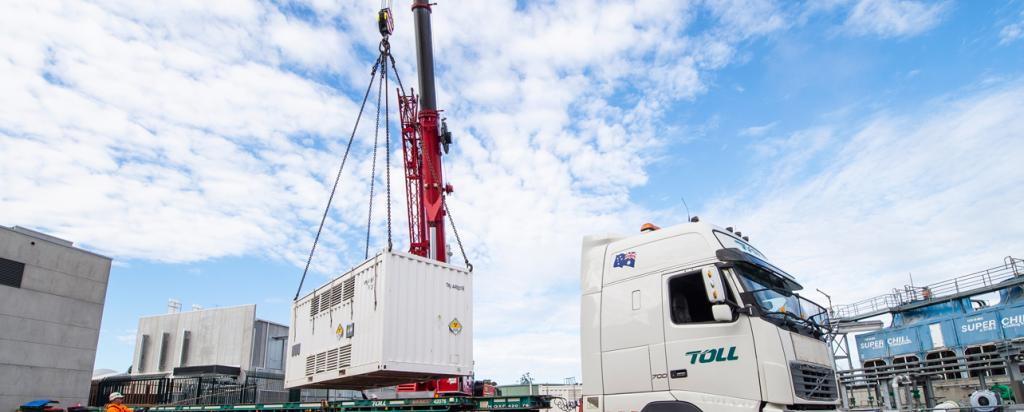
In mid-2018, ANSTO, together with several State and Federal Government agencies, will undertake Australia’s 10th routine transport of spent nuclear fuel assemblies.
In a single export, material that has enabled a decade of research and medicine production will be trucked from the Australian Nuclear Science and Technology Organisation (ANSTO) in Sydney’s South.
It will be sent to La Hague in France, where it will be reprocessed – removing unused uranium and plutonium, and safely immobilising the residual waste in glass, in a process called vitrification.
The benefits that this spent fuel has enabled include:
Production of around 5.5 million nuclear medicine doses for Australian patients since 2007, used for diagnosis and treatment of heart, lung, and skeletal conditions and cancers;
Production of millions of additional doses of nuclear medicine for patients overseas, predominantly in the USA and throughout Asia;
Development of Lutetium-177, now being used in clinical trials for neuroendocrine tumours, and prostate cancer;
Irradiation of more than 45 tonnes of silicon each year, the raw material that enables high powered electronic devices such as solar farms, hybrid cars and wind farm technology;
Ground-breaking research in areas as diverse as characterising new battery materials with greater storage capacity and discharge capabilities;
Studies of the structural integrity of materials such as critical welds in pipelines;
Improvements in the scientific understanding of the growing problem of food allergies; and
Determination of the structure and dynamics of materials used in hydrogen fuel systems.
As with nine previous shipments, this operation will be conducted in collaboration with agencies including state and federal police, road and maritime authorities, and regulators.
In line with standard operational and security requirements, ANSTO will not comment on the port, routes or timing until after the transport is complete, except to confirm it will occur mid-2018.
Media enquiries, please email media@ansto.gov.au
Frequently Asked Questions
What is being shipped?
OPAL has 16 fuel assemblies, of which two or three are replaced each month to enable ongoing operation. The used assemblies are kept in the service pool inside the reactor.
Ten years’ worth of these fuel assemblies are being transferred into specially-designed TN-MTR transport casks, and will be shipped to France for reprocessing. The casks are 2 metres high and 2 metres in diameter, lead shielded and weigh 24 tonnes when loaded.
Will the transport be safe?
Yes. The fuel is being loaded into purpose-built TN-MTR casks. These are purpose-engineered to safely transport this type of material without risk to people or the environment, and to withstand even the most unlikely and severe accidents or scenarios.
Around the world, at least 25,000 cargoes of spent fuel have been transported since 1971 without an incident involving significant radiological consequences for people or the environment.
There is no credible chance of any accident or incident that could result in the cask being compromised.
Will workers be safe?
Yes. Standing next to this container for many hours, there would be nothing anywhere near an amount of radiation that would pose a health risk.
Where is the transport going and what will happen when the material gets there?
The spent fuel is being transported to a facility in La Hague, France where it will be reprocessed.
This involves removing unused uranium and plutonium, and safely immobilising the residual waste in glass, through a process called vitrification.
What is the transport route and when will the transport occur?
In line with standard operational and security requirements, ANSTO will not comment on the port, routes or timing until after the transport is complete, except to confirm it will occur mid-2018.
How much uranium and plutonium will be removed and what will happen to it?
The useful materials that are extracted will be recycled into overseas civil power and research programs, and the remaining vitrified materials will return to Australia in several years.
Within the spent fuel it is expected there will be approximately 500 kilograms of Low Enriched Uranium and 4.5 kilograms of plutonium.
Why are we sending it to France? Why can’t we reprocess the spent fuel in Australia?
The very small volumes of spent fuel produced in Australia would make a domestic reprocessing facility uneconomic.
France has both the largest reprocessing facility in the world, and also has purpose-built infrastructure that is suitable for reprocessing research reactor fuel such as ours.
That’s why Australia, like other countries, pay to use the La Hague facility’s infrastructure and expertise.
How much will this operation cost?
Several years ago, $45 million for this project was included as a line item in the federal budget. This includes the contract with the France, and also equipment, staff and other costs.
When will the remaining waste be transported back to Australia, and where would it go?
The vitrified waste will be returned to Australia in many years’ time, and is expected to be sent to a National Radioactive Waste Management Facility, where it will be safely kept in temporary storage for several decades.
Eventually the waste will need to be moved from there to a permanent disposal facility in a different location. The Australian Government recently announced the process and framework for establishing that facility.